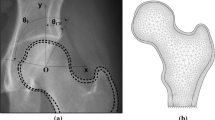Abstract
The demands associated with modeling geometrically complex anatomic structures often limit the utility of musculoskeletal finite element (FE) analyses. Automated meshing routines typically rely on the use of tetrahedral elements. Hexahedral elements, however, often outperform tetrahedral elements, namely during contact analyses. Hence, a need exists for a preprocessor geared towards automated hexahedral meshing of biologic structures. Two meshing schemes for finite element mesh development of the human hip are presented: (1) a projection method, coupled with a surface smoothing algorithm, has been applied to accommodate the near spherical nature of the femoral head articular cartilage surface, while (2) a technique termed the preferential method was developed to mesh the acetabulum. The latter technique benefits from a user traced bound of the articular surface. High-quality, three-dimensional continuum models, consisting solely of hexahedral elements, were generated for the femoral head and the acetabulum. To check the validity of the meshing routines, a transient deformable–deformable contact finite element analysis was carried out. Gait cycle kinematics and kinetics from the weight-bearing stance phase were considered. The contact pressure (1.74 MPa) was in agreement with the values reported in the literature.











Similar content being viewed by others
References
Keyak JH et al (1990) Automated three-dimensional finite element modeling of bone: a new method. J Biomed Eng 12:389–397
Viceconti M et al (1998) A comparative study on different methods of automatic mesh generation of human femurs. Med Eng Phys 20(1):1–10
Donahue TL, Hull ML, Rashid MM, Jacobs CR (2002) A finite element model of the human knee joint for the study of tibio-femoral contact. J Biomech Engineering 124(3):273–280
Grosland NM, Brown TD (2002) A voxel-based formulation for contact finite element analysis. Comput Methods Biomech Biomed Eng 5(1):21–32
Anderson DD et al (2006) Intra-articular contact stress distributions at the ankle throughout stance phase––patient-specific finite element model analysis as a metric of degeneration propensity. Biomech Model Mechanobiol 5:82–89
Andreasen NC et al (1993) Voxel processing techniques for the antemortem study of neuranatomy and neuropathology using magnetic resonance imaging. J Neuropsychiatry Clin Neurosci 5:121–130
Andreasen NC et al (1992) Image processing for the study of brain structure and function: problems and programs. J Neuropsychiatry Clin Neurosci 4(2):125–133
Wyvill G, McPheeters C, Wyvill B (1986) Data structure for soft objects. Visual Comput 2:227:234
Shepherd DET, Seedhom BB (1999) Thickness of human articular cartilage in joints of the lower limb. Ann Rheum Dis 58:27–34
Mow VC, Hayes WC (1991) Basic orthopaedic biomechanics. Raven Press, New York
Maxian TA, Brown TD, Weinstein SL (1995) Chronic stress tolerance levels for human articular cartilage: two nonuniform contact models applied to long-term follow-up of CDH. J Biomech 28(2):159–166
Pedersen DR, Brand RA, Davy DT (1997) Pelvic muscle and acetabular contact forces during gait. J Biomech 30(9):959–965
Greenwald AS, O'Connor JJ (1971) The transmission of load through the human hip joint. J Biomech 4(6):507–528
Acknowledgments
Financial support from the Whitaker Foundation, National Institutes of Health (Award EB001501), and the Colleges of Medicine and Engineering at the University of Iowa is gratefully acknowledged. The authors would also like to thank Dr. Vincent Magnotta and Dr. Thomas Brown.
Author information
Authors and Affiliations
Corresponding author
Rights and permissions
About this article
Cite this article
Shivanna, K.H., Grosland, N.M., Russell, M.E. et al. Diarthrodial joint contact models: finite element model development of the human hip. Engineering with Computers 24, 155–163 (2008). https://doi.org/10.1007/s00366-007-0083-9
Received:
Accepted:
Published:
Issue Date:
DOI: https://doi.org/10.1007/s00366-007-0083-9




